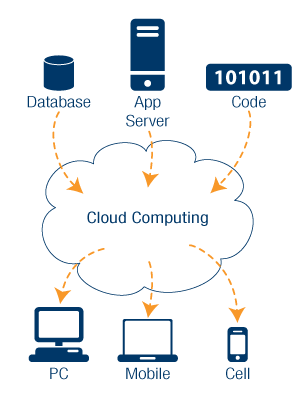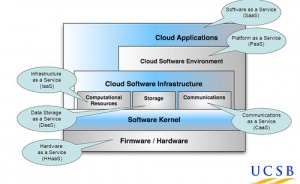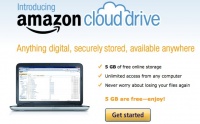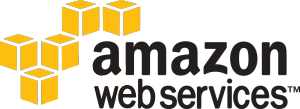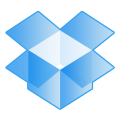Difference between revisions of "Cloud Computing"
(→Dropbox) |
|||
| Line 118: | Line 118: | ||
[[File:Dropbox.png|thumb|120px|right|Dropbox logo]] | [[File:Dropbox.png|thumb|120px|right|Dropbox logo]] | ||
| − | Dropbox is an application that can be installed on both a computer and [[Android]] and iOS devices. It allows the user to easily upload, access, and share files on the go. The user can save something on their computer and access it on their mobile device. The user can also authorize people to have access to certain Dropbox folders to facilitate easy file-sharing among multiple people. With a basic free service of 2.5 GB, a user can gain more space by inviting people to use the service. The user selects files to load into the dropbox folder, but maintains the copy on the physical computer. | + | Dropbox is an application that can be installed on both a computer and [[Android]] and iOS devices. It allows the user to easily upload, access, and share files on the go. The user can save something on their computer and access it on their mobile device. The user can also authorize people to have access to certain Dropbox folders to facilitate easy file-sharing among multiple people. With a basic free service of 2.5 GB, a user can gain more space by inviting people to use the service. The user selects files to load into the dropbox folder, but maintains the copy on the physical computer. Dropbox offers a social side to their service by allowing users to increase their data storage by inviting friends. For each referral that signs up, the referer gains an allotted amount of storage. |
===Box.com=== | ===Box.com=== | ||
Revision as of 04:47, 19 December 2011
Cloud computing is the practice of offering shared computational resources to end-users through remote servers. It offers storage, management, and processing of data to an end-user from a centralized location, without needing powerful individual machines to carry out computational tasks.[1] The processed data files can then be transferred over network connections as documents, emails, or applications. Access and delivery of data is done through applications such as web browsers[2], which require far lower computational resources than data processing. This method is more cost-effective than the alternative.[3] Furthermore, and more professional definition according to National Institute of Standards and Technology (NIST), Cloud Computingis a model for enabling ubiquitous, convenient, on-demand network access to a shared pool of configurable computing resources that can be rapidly provisioned and released with minimal management effort of service provider interaction.
Contents
Overview
Cloud computing delivers computational capability from a centralized source to an end-user via an internet connection. Once the connection from host to end-user is made through the connection, multiple levels of service can be achieved based on the user’s needs and the system’s specifications.
Layers of Cloud Computing
Shared cloud computing resources range from simple applications, in which users only have access to the functions provided by the application, all the way to shared operating systems which are run remotely on the server. The levels of software abstraction available to the user through the cloud are relative to the purpose of the system.
Cloud Deployment Models
Cloud computing Networks have 3 deployment models which are specific solutions offered to business based on their own specific requirements and preferences.
- Public Cloud: Is a cloud infrastructure that is made available to the general public or a large industry group and is owned by an organization selling cloud services. Popular examples of public cloud include Google - Gmail, and Amazon - EC2.
- Private Cloud: Is a cloud infrastructure that is operated solely for an organization. It can be managed by the organization or a third party which can exist off premises. This deployment model is most well suited for businesses who plan to use cloud computing as an IT tool. Many companies offer services to build in house private clouds, including Dell, HP, and IBM.
- Hybrid Cloud: Is a cloud infrastructure that is operated as a composition of two or more clouds usually a private and public cloud that remain unique entities but are able to be scaled up when load dramatically increases.
Characteristics of Cloud Computing
The National Institute of Standards and Technology, NIST, identifies 5 major characteristics that they believe are essential.[4]
- Customer-initiated service that provides server time and network storage.
- Network access from different electronic devices (laptops, mobile phones).
- Computer resources to be used for all different types of resources according to costumer demand.
- Capabilities for very easy revisions and access.
- Measured services that can be controlled and monitored by both the provider and customer so information will be stored accurately.
“Software as a Service”
Cloud computing often employs “Software as a Service” (SaaS)[5], in which software is “delivered” to end-users by way of network connections as opposed to being sold to the end user and operated locally. Contrasted with software being seen as a static part of the computational process, this shift in paradigm allows software’s computational nature to be seen as a resource. Essentially in SaaS an application is hosted by a cloud service provider and users can access and utilize the software through the internet using a browser. Common examples of Saas include web-based email services offered my companies like Google (Gmail), Yahoo!(Yahoo mail). Furthermore SaaS can be divided into two categories:
- Line of business services: Business solutions which are offered to companies and enterprises and sold via subscription. Examples of such software include supply-chain management applications, customer relations applications, database products and similar products. Force.com a company which has pioneered cloud computing SaaS applications product salesforce.com has many examples of products for business and enterprise customers.
- Customer-oriented services: These are services which are offered to general public and are usually free and supported by advertising. Examples of these products include web mail services, online gaming, and consumer banking products.
Popular SaaS applications in market today are:
- Google - Google Apps and Google Apps Premier Edition: Communication and collaboration software which are designed for businesses use. Features include tools such as email services, Google Calendar, Google talk, Google Docs and Spread sheets.
- Microsoft - Microsoft Office Live Small Business includes wide variety of tools useful for small businesses.
- IBM - Blue Cloud
Advantages of SaaS adoption
- Faster time to value and improved productivity compared to implementation and failure of utilizing traditional enterprise software.
- Lower software licensing costs, and elimination of need to install and maintain hardware, pay labor costs, and maintain applications.
"Platform as a Service"
A more server-heavy implementation of cloud computing is "Platform as a Service," or PaaS. PaaS remotely hosts software that is used to develop other software, such as Adobe Creative Suite or Microsoft Visual Studio. Paas allows multiple developers to work on the same project more easily, as well as saving the developer money and resources by licensing and running the software remotely. In other words, Platform as a Service delivers a solution stack or a software development kid which provides tools that a developer would need to build an application. Other examples of PaaS include Google App Engine, Force.com, and Microsoft Azure Platform. </ref>
"Infrastructure as a Service"
This form of cloud computing offers the user storage, networking and processing power with few or no bundled applications. This is primarily useful for companies with large amounts of data processing to do that do not wish to maintain their own servers. IaaS can be seen as the delivery of computer hardware(servers, networking technology, storage, and data center space, and operating systems which a business would need as an IT resource. Furthermore its major selling point is that it allows for dynamic scaling based on load. Currently the most popular IaaS operation is Amazon EC2 Cloud. This cloud hosts many popular sites such as reddit.com. In addition other companies which offer similar services include Rackspace.com and IBM.[6]
Ethical Implications
One of the largest ethical concerns deals with the illegal exchange and sharing of information within the cloud interface. This issue is hotly debated and difficult to resolve due to various copyright and licensing regulations. Cloud computing presents users with ethical dilemmas about whether or not it is legal to gain access to certain materials through a cloud sharing interface. The monitoring of these central networks keep control of who has access and to what specific pieces of information can be obtained.
Cloud computing has also increased the awareness about protecting private user data that is on the internet. Although people have always been aware about the security of the private data that they release to companies and websites, cloud computing has created a new realm for concern. Many companies have started to implement the use of the "cloud" into their products, the most famous being Apple's new feature iCloud. Amazon has also become a heavy supporter of cloud computing technology, providing cloud storage for all of their users.
Amazon has also incorporated cloud technology with their new product, the Kindle Fire. The web browser on the Kindle Fire, called Amazon Silk, is a purely cloud based browser which sends all the information you are requesting to Amazon's cloud servers, which in turn send them to the domains. This technology takes advantage of the high speeds of cloud databases instead of relying on the Fire's wireless connection. [7] Although this does increase the speed of web browsing, it also raises the concern of what Amazon is doing with all of the private information that users are sending to its cloud servers. Since almost none of the computing is done by the Fire itself, Amazon has total control of the information that is sent.
Cloud Security
Cloud Security refers to the issues or barriers which are currently preventing wide spread adoption of the cloud computing enterprises around the country. Furthermore, security issues in cloud computing provide a basis upon which ethically relevant concerns exist in the cloud. When placing sensitive documents into the cloud, companies are concerned that hackers will gain access to private documents, making them hesitant to utilize this technology.
Performance
An area where ethical concerns are relevant is cloud performance. Cloud networks are vulnerable to attack due to the nature of their convenience. A cloud is built on the idea that it is accessible from any interface which allows internet connection. This positive attribute can also cause many people to attack and hack this network. Furthermore, this has been a concern as recently Amazon.com and Google clouds have been attacked by DDoS by essentially using thousands of fake requests stopped both websites from operating. Performance of the cloud is a major selling point. When providing services, ensuring that service will not be interrupted has ethical implications. When providing a service which is a backbone for any corporation, for example the inability to access their information, can harm both parties. Furthermore, because cloud computing is available on such a variety of clients it creates a situation where users are potentially forgoing security in exchange for convenience. Furthermore in a worst case scenario data which users upload can be lost, stolen, or harmed. However in such a situation who is responsible for the hack and protection of property after such an attack has occurred. These security issues can give rise to many ethical concerns which users have to understand before utilizing cloud technology.
Data Migration
This topic can be further expanded under the term of data migration. Data migration seeks to understand the issues which arise when data is moved seamlessly from one server to another. Steps need to be taken to ensure no data is lost, as well as availability, scalability, cost efficiency and load balancing. Before service providers offer services they need to have knowledge of their product and its abilities. More over, the way they charge their consumers is an ethical concern. Cloud computing is built on the idea that users do not need to understand or have knowledge of underlying technology which makes their work possible. A divide of knowledge is being created where people using technological services do not know what services they are getting. In this case the providers have power in how much to charge for services and ensuring that proper levels of service are provided. This requires ethical standards to be created and maintained on the service providers side. This situation can create ethical problems for two reasons. First, cloud computing is built on the idea that users do not have in-depth knowledge about technology they are paying for and using. In the situation where data is lost, or service is interrupted responsibility rests solely in the provider to work with the user in an ethical manner, by recovering data and charging them appropriately. However, in a worst case scenario without regulation it is possible service providers essentially lay claim to a users data, essentially information in the cloud can be held hostage and this is morally questionable. Furthermore companies fear this situation and is professionally referred to as Lock-In.
Data Governance
Finally the last ethical conflict which can arise in a cloud environment deals with data governance or essentially who makes the rules or laws regarding cloud computing. Since cloud computing is a newer technology which is being used there are no legal standards to control the amount of information which is uploaded to the cloud environment. A major technological characteristic of cloud computing is that multiple copies of data are created to ensure data is never lost, and these data copies are moved from server to server. While these ideas are beneficial and integral to making cloud services possible, the current legal definitions of data control and mobility do not tend to apply. For example, if data is uploaded to the cloud, it is moved from a users computer to a third party service providers server. Who is the owner of this data? Is it the user who uploaded it or is it the third party who is actually housing and hosting the data. An example of where this is already an issue is Germany. By law Germany does not allow a companies information to be removed from the country. However, on the Cloud the data can be on many servers at the same time which are located in many different places. Another ethical issue with the cloud is once data which is on a third parties cloud they have the power to access it. Ethically this enters a gray line, if they find the data is nationally compromising is it the companies responsibility to report it to the government? However, at the same time what gives a third party the right to access a consumers data which they in confidence that their data was protected uploaded it online. This ethical implications of this can be seen when for example Google complied with US laws and revealed European Information on their servers to the United States Government.[8] In another example, the NSA requested access to phone calls and Verizon and AT&T and complied giving this government agency a database of phone calls made on these networks. [9] As clouding computing will further foster spread of information and communication the lack of established laws create a situation where many ethical concerns in Cloud Computing. The most important of them relate to the way data is put on the internet and way it is charged as well as who has access to the information and how it can be used.
Benefits of Cloud Computing
Efficiency & Cost Management
Cloud computing allows efficient use of IT resources. With all computation being done in a single locale, the cloud system can be engineered to fit the demand for resources. Resources over and above demand can be powered off, or utilized in other ways to make the cloud computing system more efficient.[10]
Ease of Maintenance
With all software and hardware being stored in a single location, upgrading and updating of infrastructure must be done only one time at the central location, as opposed to multiple times at each access point. Centralized control for maintenance allows for more uniformed upgrading as well[10].
Redundancy
The more cost-effective nature of centralized cloud resources allows system fail-safes to be put in place more easily. For instance, if one server fails, a secondary server can be used to take its place. In comparison, a set of dispersed individual computers that fail simultaneously are much more difficult to repair[10].
System Access
When companies hire new employees they must install various software packages onto their computers. This usually is a long and tiresome process because many of these packages require certain product licensing numbers. However with cloud computing they can establish an internal network where they can access these required programs with ease because they are stored online in the cloud network. This is quicker and easier than manually downloading them onto each specific computer.
Convenience
These services have revolutionized and upgraded the utility and attractiveness of cloud computing for the average consumer. By offering a safe place to back-up files and storage, it allows consumers and companies to increase storage and capability without investing capital into new servers, infrastructure, information technology services, and licensing. Cloud computing eliminates the costly overhead for subscription servers and pay-per-use services, extending information technology's reach across the internet. Cloud services provide these ample, but innovative conveniences for users.
Drawbacks of Cloud Computing
Data Sharing & Copyright Infringement
Access to copyrighted material through the cloud raises complex legal concerns. The easy dispersion of digital material not owned by users of the cloud, but disseminated through its infrastructure can constitute copyright infringement for the user and bring legal ramifications for the cloud provider. Concerns also exist about the ownership of data stored on cloud servers. For instance, is information that is saved on the cloud the property of the individual that generated it, or property of the individual upon whose server the information is stored? [11]
Security Concerns
Information stored in a single location can potentially be subject to easier breaches in security. Having all data exist centrally allows more users to access said information, while creating a one-stop-shop for hackers to obtain classified or potentially damaging data. Ethical concerns also exist because a level of trust is required when an individual's personal information is saved on physical hardware which they cannot access or protect.[12]
Examples of Cloud Computing Services
Amazon Web Services (AWS)
Amazon provides various cloud services, including the S3 (Simple Storage Service) that provides data storage and EC2 (Elastic Compute Cloud) that is a platform to run programs and computations.
Amazon has become the industry leader in the emerging market of cloud computing. Many emerging companies, particularly those with websites that have heavy traffic or deal with fast increases in production, have turned to AWS to handle their data storage. AWS has become the de facto cloud computing platform for many because of their reputation of dependability and security, as well as an easy to use interface.
The massive growth of AMS and Amazon has prompted ZDNet's Larry Dignan to state, "Amazon will be like a book store that sells cocaine out the back door. Books will be just a front to sell storage and cloud computing."
Apple's iCloud
iCloud was released on June 6, 2011 at the Apple Worldwide Developers Conference. The free service allows users to store their mail, contacts, photos, calendar, and more information on Apple's cloud servers, and push the data to all iOS devices. This allows users' iPhones, iPads, and iMacs to be synced wirelessly and automatically. Users were required to update their existing software to iOS 5 for mobile devices and to Lion for laptops and desktops in order to utilize the technology. Lion had some initial issues with the upgrade, restricting the number of people who have adopted the technology. Developing from Apple's MobileMe software, iCloud improves upon automatic synchronization and connecting all web-enabled Apple devices. The cloud technology also utilizes the technology to print documents from a user's mobile device.
Apple does not directly provide all of their iCloud storage. Part of the cloud services Apple utilizes is based in the Amazon Web Services cloud servers.
Dropbox
Dropbox is an application that can be installed on both a computer and Android and iOS devices. It allows the user to easily upload, access, and share files on the go. The user can save something on their computer and access it on their mobile device. The user can also authorize people to have access to certain Dropbox folders to facilitate easy file-sharing among multiple people. With a basic free service of 2.5 GB, a user can gain more space by inviting people to use the service. The user selects files to load into the dropbox folder, but maintains the copy on the physical computer. Dropbox offers a social side to their service by allowing users to increase their data storage by inviting friends. For each referral that signs up, the referer gains an allotted amount of storage.
Box.com
Box.com is a provider of cloud storage and seeks to differentiate itself among its competitors by targeting businesses and corporations. As part of the upcoming University of Michigan NextGen plan, the University of Michigan will utilize Box.com services for many of its backup data storage.
Steam Cloud
Steam cloud is part of the steam gaming platform.[13] The service allows games that run on the steam gaming platform to write and retrieve files for each user. It is can be used for settings such as keyboard, mouse and gamepad configurations, or even saved games. It is designed to make playing Steam games from different computers easier for the consumer.
See Also
References
- ↑ Cloud Computing
- ↑ Advanced Browsers Are Key To Mobile Cloud Computing
- ↑ In Cloud Computing We Trust—But Should We?
- ↑ The Real Realities of Cloud Computing: Ethical Issues for Lawyers, Law Firms, and Judges
- ↑ Cloud Computing: The Evolution of Software-as-a-Service
- ↑ Corbett, Susan. "Creative Commons Licences, the Copyright Regime and the Online Community: Is There a Fatal Disconnect?" The Modern Law Review 74.4 (2011). Print.
- ↑ Amazon Silk. Retrieved on 2011-12-07.
- ↑ http://news.softpedia.com/news/Google-Admits-Handing-over-European-User-Data-to-US-Intelligence-Agencies-215740.shtml
- ↑ http://www.usatoday.com/news/washington/2006-05-10-nsa_x.htm
- ↑ 10.0 10.1 10.2 http://resource.onlinetech.com/the-six-benefits-of-cloud-computing/ The Six Benefits of Cloud Computing
- ↑ Cloud Computing, Digital Lockers and Copyright: The Cloudification of Entertainment
- ↑ The Privacy Implications of Cloud Computing
- ↑ http://steampowered.com/steamworks/ov_cloud.php
